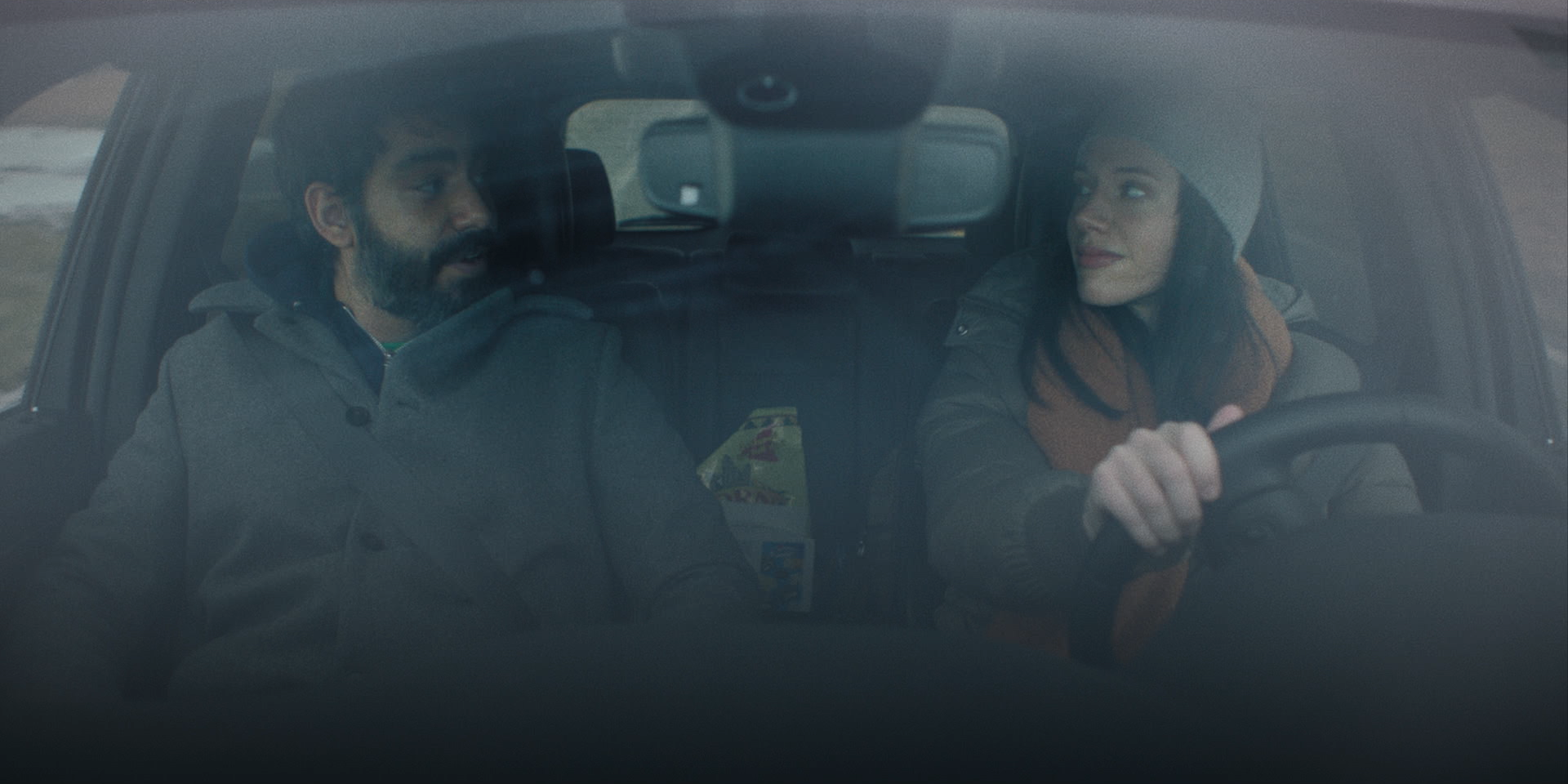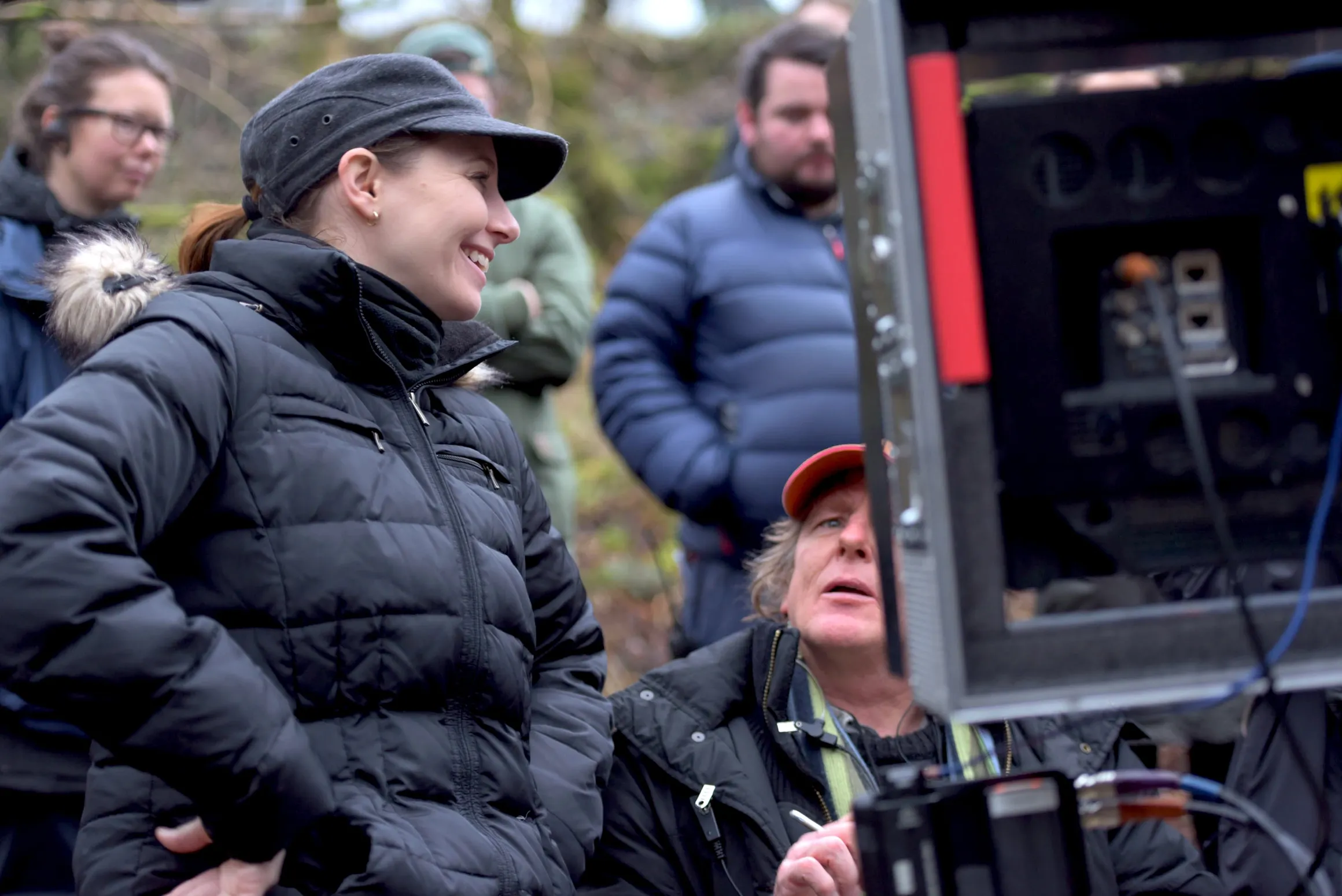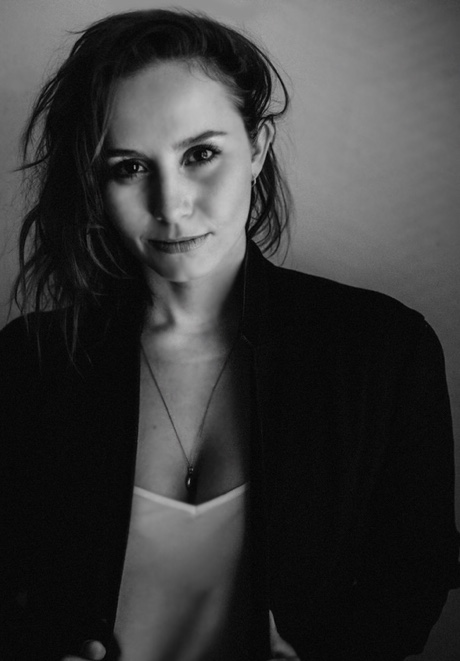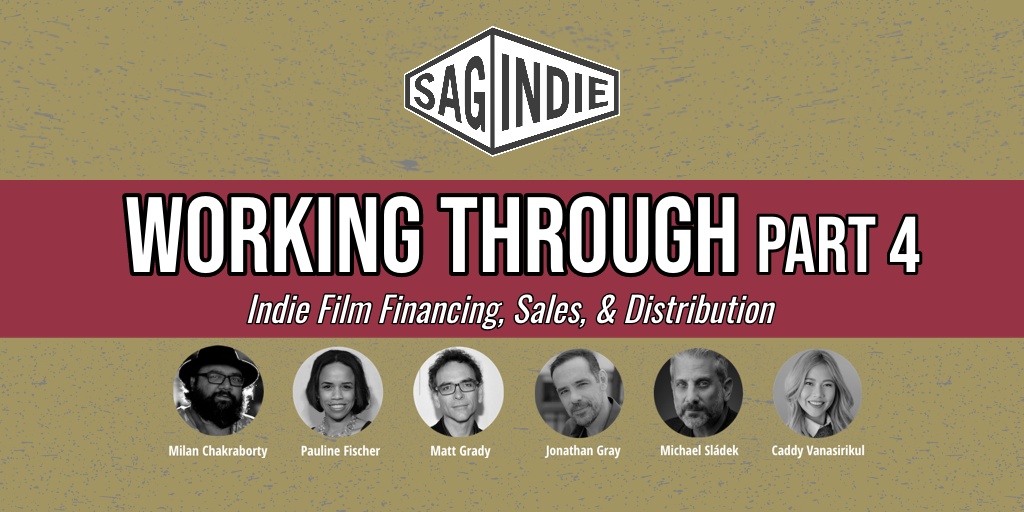Filmmaker MALI ELFMAN has made movies in all genres but has found a particular niche in horror. Her newest film — her first as a feature director — melds horror, sci-fi, and romantic comedy elements into the stylings of a road trip movie. In the near-future world of NEXT EXIT, a famous research scientist (Karen Gillan) has found proof of the afterlife. This discovery inspires two strangers, Rose (Katie Parker) and Teddy (Rahul Kohli), to drive cross-country together — clashing personalities and reflecting on the lives they’ve led — in order to pursue the experimental journey of life after death.
Although Next Exit is Elfman’s feature debut as a writer/director, her extensive producer credits include Marianna Palka’s Bitch, Mike Flanagan’s Before I Wake, Karen Gillan’s The Party’s Just Beginning (which landed a BAFTA nomination for Best Feature Film), and the anthology feature Do Not Disturb. As a director, she’s made multiple shorts including Do You Believe in Ghosts? and Voice, and has had her work (both behind and in front of the camera) featured in the Fun Size Horror film series.
Next Exit premiered at the 2022 Tribeca Film Festival and hits theaters and VOD on November 4, courtesy of Magnolia Pictures and Magnet Releasing. Writer/director Mali Elfman took some time to chat with us about her career, her inspirations, and taking the Next Exit production on the road.
——
COLIN McCORMACK: There are a lot of ways you could tell a story about death and what comes after. What inspired you to frame this story as a multi-genre road trip movie?
MALI ELFMAN: I didn’t intend it to be multi-genre, it just happened that way. That’s kind of the way that I work. I always wanted it to be a character study between these two characters. That was always the most important thing for me and that’s where I started, the backstory of these characters and why they were there. I actually wrote a lot of monologues and dialogue and poetry about them that would never be in the film before I really started. That’s part of why this process took so long. Then it was about what was the structure that I wanted to get them to this emotional catharsis, eventually. There is something about whenever I’ve been trapped in my own way, two of the biggest things that help me get out of my own head are nature and other human beings. It’s great when it’s family or somebody that’s close to you, but I have found that some of the most defining moments are with complete strangers that I meet and have some type of revelation that I wasn’t expecting to have. I’m also the person that loves going to a pub and sitting down and asking the person next to me, “What’s your story?” So I think that’s kind of the vibe that you get.
Also, it was very important to me that as the story opened up, we also opened up into nature and we showed the beauty of the world. By the end, we’re seeing the stars in the sky. That has always helped me to feel both completely insignificant and yet my journey matters. That was something that I really wanted to portray. And if they would’ve flown there, it would’ve just been too fast, so I just needed them to take the time. I’m also a road-tripper. I’ve crossed this country so many times and I think it’s such an important [thing] to take the time to actually process your feelings and look at the world around you.
CM: You’ve obviously produced a lot of films. Was this the first feature project where you really wanted to pursue directing or were you close to directing other features before this?
ME: I’ve been trying to direct features for a while. [Laughs] People just don’t always let you, which is the problem. If people let me do what I want, I would’ve done this a while ago. But I’m actually grateful that they didn’t because I grew so much. I did four short films on the way and by the last short film, I felt very confident finally about stepping into being a feature film director. I’ve also produced for several first-time feature film directors and I think that that let me see the common problems, the common experience, and go into this feeling like I was a little bit more prepared. I could produce myself a little bit in prep so that I was in the right place and then I could trust my producers [Derek Bishé and Narineh Hacopian].
Honestly, I never thought [Next Exit] would be the first one to get made. There were other ones that are much more “marketable” or “sellable” or whatever, that fit into a specific genre. I met with Helmstreet Productions and I pitched them my slate. It’s funny because I didn’t [initially] pitch them this one. On a Zoom I was just like, “Oh, I do have this passion project.” And they said, “Can we read that?” And then, sure enough, that was the one. The hardest part about this one is that it’s such a delicate tone. It’s completely character-driven and if you don’t nail the performances, you’re screwed. I think a lot of investors wouldn’t take that risk, so I’m very lucky to have met Helmstreet, who said, “We believe in you.” That was crazy and I still don’t believe it. I still call them unicorns. But they are real and they are very good friends of mine now. They’re just very good human beings.
CM: What was the timeframe from when you first started on the script to when you actually started that first day of production?
ME: The whole thing has been about a decade. It’s so nebulous though because it was me just writing on my own. It was me writing poetry. I remember I was sharing some of that poetry with Katie Parker early on [before] she read the film. It was funny because I’ll write a ton of poetry and then just one line of it will go into a monologue. That’s all that I end up using. Katie’s like, “I remember that line!” That’s how you get those gems, at least for me. If I’m trying to write those in the moment, it doesn’t work. So a lot of those come from free writing and then you highlight the good ones and eventually, you find a place for them. Yeah, it’s been a long process. A long time in the making.
CM: And speaking of Katie, how did you end up finding your cast? Like you said, it’s so character-driven and the two leads’ chemistry and relationship are everything.
ME: Katie did a reading of a script ten years ago for me and we met and became friends right after that. So we’ve been friends for years. She was actually in a short by [Next Exit co-star] Rose McIver called Nice Ride. I remember seeing a new level of maturity in her acting. It had been ten years and I realized she’s gotten really good. And then just seeing her performances, seeing her as Poppy [in The Haunting of Hill House], she’s such a chameleon. I don’t think [the character] Rose is anything like Katie and so I knew she was going to have to transform and I knew that she was the actor who could do that and would be willing to go to the depths of where Rose needed to go, which I think is scary for a lot of actresses.
Then Raul was my first pick. I used all my ties from Mike Flanagan and Rose McIver and through his agents, through our casting director, I just stalked the hell out of him. I was willing to go to some others after he said no, but he was number one on the list. And he resonated so strongly with it and we just took off flying. I was a fan of his from iZombie and Bly Manner. I thought he was amazing.
CM: Was there time or money for rehearsal?
ME: We never rehearsed. It was also the height of the pandemic. So this is January 2021 when we were shooting. [Rahul] was on Midnight Mass until the end of December. We did one Zoom beforehand. That was it. With Katie, I had gone through the script line by line very specifically. We had talked about everything. With Rahul, I had two broader, macro conversations about backstory. He was much more into what happened before page one because then he could make the decisions that he would need to. And so that was the conversation. I got them both on a Zoom and it was so clear that they both have completely different ways of working. And I was like, Ooh this is gonna be great. Let’s lock ’em in a car together and I’m just gonna get the natural fireworks. Because both of them are a little bit fiery. But the thing is, both of them also respect and listen to one another. Really, the trick is that I knew both of them would show up for one another but I also knew that both of them have a little bit of those fireworks. That’s what makes it interesting and fun.

CM: And logistically, speaking of them being in a car, how difficult was it to have so much time spent in such a cramped – and moving – location?
ME: It was really hard. It was a really stupid idea and I never want to do it again [laughs]. It’s funny because I’m writing [a script] and there’s a car scene and I’m just like, Oh God, I don’t want to shoot it. It’s hard because everybody is asking me how many days I shot and I genuinely don’t know because days of travel, like from Kansas City to New Mexico, was 12 hours that counted as a day. We were also shooting out the windows the whole time. I would swap Katie into the front seat. There is one shot that made it into the film where I actually put on Teddy’s coat and his hoodie and Katie’s driving and so I’m actually Rahul. See if you can find that one. It was very funny, just to get one over-the-shoulder of Rahul to Katie. And Rahul and I apparently have the same build.
CM: It worked out. I wanted to ask about the locations. When you have a road trip movie, obviously you need to cover a variety of terrain. How many places were playing triple duty as other locations and how many actual individual states did you film in?
ME: We started in Kansas City, Missouri. That was kind of everything once you left New York. It was a little bit of New York when they were in the parking lot, that’s actually Kansas City. And then it played as Kansas City and Ohio. Then we went to Tucumcari, [New Mexico] and shot on the way down. That was actually stuff that was used for the road trip part. And we were in Tucumcari, where we shot all of the interiors of the motels at three different motels there and two of the exteriors. Tucumcari was the place that we were at the longest, eight whole days, which is wild. Then we went through Moriarty, [NM] and got a gas station. Literally, this was our day: Shoot one scene, pack up the cars, drive three hours, get to Moriarty, shoot for an hour-and-a-half, get a gas station scene, drive two hours, get to Albuquerque, pick up an exterior of them walking in. That was our day.
It’s hard because it’s not like you were shooting 12-hour days, you were just shooting what you could as you could. That was really the feel of it. Then we got to Albuquerque and shot the big bar sequence there and shot outside the diner that was [supposed to be] Arizona. And then we shot going through Arizona for exteriors. Interiors were back in LA. Anything with another actor – other than Diva [Zappa], other than the clerk and the gas station attendants, which were our crew, by the way – we shot in LA to get the interiors there and to get [other] actors. It was too hard with COVID protocols to do that while on the road.
CM: [Slight SPOILER territory here] What were the inspirations for visualizing the afterlife scenes?
ME: For me, the ghosts in the movie are very much how I’ve experienced visions, apparitions, spirits, ghosts, whatever you want to call them. It is a lack of light. So very much for me on the other side, I wanted it to be in darkness and I wanted them to actually be the thing that is the light in the dark. The name of the [production] company is No Traffic for Ghosts because I don’t believe we go to the other side and it’s just ghosts everywhere. You go to your void. There are different timelines, there are different realities, there are different things on top of one another. So for Rose, ultimately what you do is go into this beautiful place that would probably be somewhere wonderful that she could lead herself to. But because she hasn’t dealt with all the issues of her past and she hasn’t forgiven herself, she’s ultimately going to be trapped in what she hasn’t been able to let go of. I know it’s a little bit of a spoiler, but for me, that was important in wanting to not represent the other side as necessarily scary, but actually something that might be needed.
CM: What was the post-production process like for you? Was this the most involved you’d been in that stage?
ME: Do Not Disturb I was definitely in. That was my first film ever and I was a part of every single piece of that. And I was pretty involved in The Party’s Just Beginning. I am a producer that likes to be more involved. I love a sound mix, my favorite time, I love foley. Honestly, my post team is the best team ever. I worked with [editor] Brett Bachman before. We had to cut this in I think it was six or seven weeks, which is bananas but we did it. I brought him on the road. He’s the clerk, by the way, that checks them in, and he was fantastic. Ariel Marx was our main composer, who is a genius at writing the tone of all the different genre-blending that we did. And Bryan Parker, who does all of my sound design, he did the sound design, the sound mix, sound editing, and he’s just a whiz. We were working on the weekends, between things in the evenings, so it was all over the place. It wasn’t like we started and stopped. We just made it happen one way or another. Freddy [Bokkenheuser] over at Picture Shop, who does color for me every single time, he’s just the best.
Honestly, it feels like coming home because I’ve worked with all these people in post so many times before and I really trust them. And I trust them to tell me when I’m making bad choices, I trust them to say no to me. My producer said to me, “You’re the exact opposite of a lot of others. You surround yourself with a lot of ‘no people.’” You’ve got to be able to hear that. So in post, I do have a lot of people who tell me no a lot, and if I can argue with them and win, then it’s worth it and if not, I just drop it really fast. That’s one of my theories.
CM: Since you do have this history of other films that you produced, did you sort of have a pathway of where you wanted to try to take the film? Festival-wise or distributors to approach, did you have an early idea or did you tackle it after you got through filming?
ME: I didn’t think about it at all, honestly. I had put together a list because I have a list that I go to all the time. And I was very excited to work with XYZ [Films], who sold the film. I’ve known XYZ for a while. XYZ has told me no many times. So when they said yes, I was very excited. I’ve worked with Pip [Ngo] over there before and he’s been a champion of mine in really wanting to support me. So when I brought him in, it wasn’t even finalized. He came in and watched it at the final mix and they picked it up from there. It was incredibly exciting to work with them. And they did a great job at Tribeca, premiering it and getting it seen so that Magnolia would pick it up. It’s been great working with Magnolia. It is funny, I was talking about this last night with somebody at the premiere, that this film knows what it wants. I can try to force things or do things, but it won’t do it, it will stay on its path. So I always feel like I’m just allowing it to do what it already was meant to do. I’m trying to help it where I can, but the film feels like it is an entity unto itself and I’m just here to make sure that I open the door when it needs me to.
CM: And then to wrap up, what’s next for you? You seem to always have a project in the works.
ME: Yeah, I’m in post right now on a project called Birth/Rebirth that Laura Moss directed. And then, I hopefully will be directing another film very soon. It will be a horror film, that’s the only thing that I can say. There will be blood.

__
Thanks to Mali for talking to us about NEXT EXIT. Learn more about the film at Magnet Releasing’s website or follow the film on Twitter, Facebook, or Instagram.
If you’re an independent filmmaker or know of an independent film-related topic we should write about, email blogadmin@sagindie.org for consideration.




